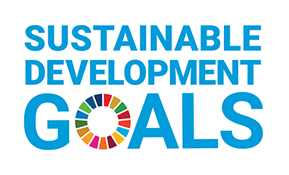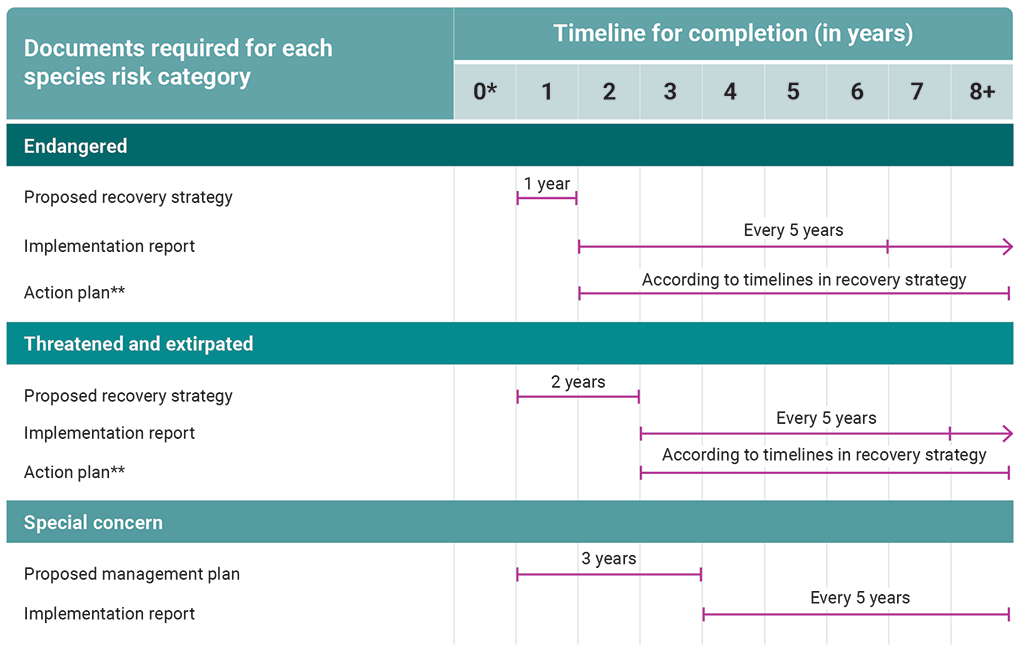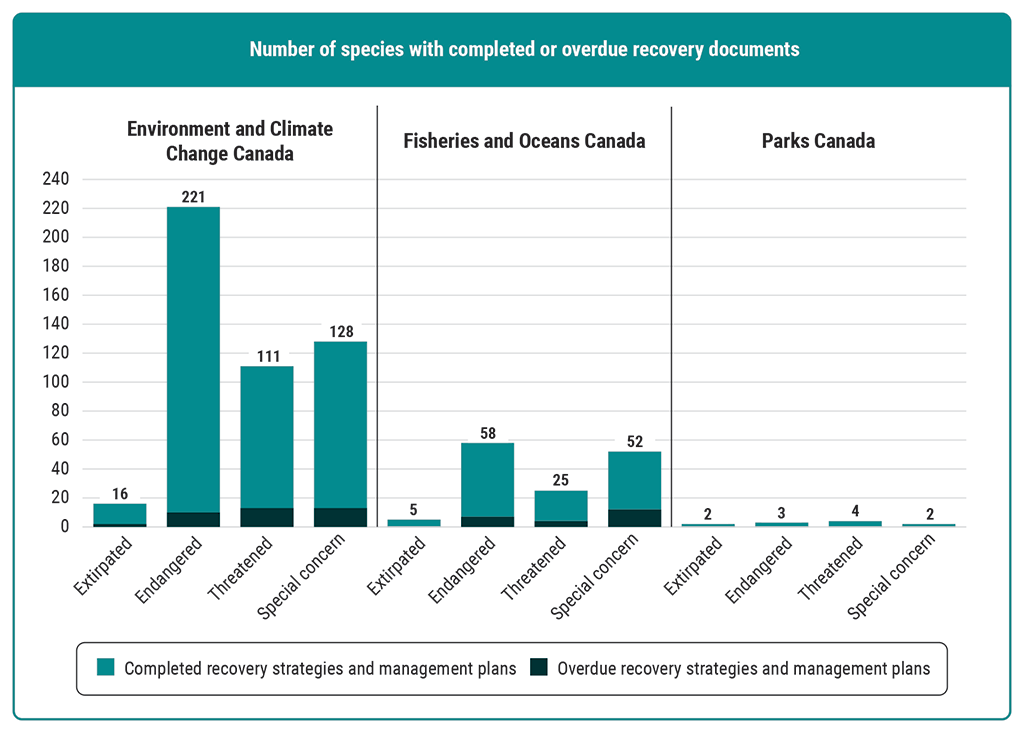2023 Reports 1 to 5 of the Commissioner of the Environment and Sustainable Development to the Parliament of Canada
Report 2—Follow-up on the Recovery of Species at Risk
At a Glance
Overall, Environment and Climate Change Canada’s, Fisheries and Oceans Canada’s, and Parks Canada’s efforts to plan and report on the recovery of wildlife species at risk under the Species at Risk Act and to contribute to Canada’s commitment to halt and reverse biodiversity loss by 2030 were lacking. This is because the 3 organizations did not complete all of the 4 key documents needed for the management and recovery of a growing list of wildlife species at risk.
While most endangered or threatened wildlife species at risk listed under the act have a recovery strategy, more than half of the action plans needed to support their recovery had not been developed. Environment and Climate Change Canada was responsible for the majority of these overdue plans. Action plans are necessary because they outline the projects and activities that need to be taken to address recovery strategy objectives. Without them, the risk is that species’ numbers will continue to face threats and their declines will increase. Of the species at risk that have been reassessed since 1982, 17% were reclassified in a higher risk category, and 63% had no change in status.
We also found large backlogs of reports on the progress made in achieving recovery objectives in species’ recovery strategies and management plans. For example, Environment and Climate Change Canada had completed only 1 of the 399 reports that it was required to produce under the act. This is important because these reports include progress on a species’ recovery objectives, along with the actions taken to protect and recover a species as well as its habitat and to mitigate threats.
In the almost 20 years since the Species at Risk Act came into effect, pressures on wildlife and their habitats have only mounted. In addition, the number of species listed under the act is expected to rise, requiring more recovery plans and implementation reports than the number that the organizations are already struggling to keep up with. In some cases, adopting a multi-species approach to planning, reporting, and recovery efforts may improve backlogs and the federal government’s ability to provide better outcomes for species at risk.
Why we did this audit
- The diversity of wildlife species continues to decline in Canada, and more wildlife species could become extinct, extirpated, endangered, or threatened soon if they are not adequately protected.
- The lack of progress toward meeting recovery objectives means that wildlife species at risk continue to face extirpation or extinction.
- Recovery strategies and related action plans set out what must be done to stop or reverse the decline of a wildlife species that has been assessed as threatened, endangered, or extirpated in Canada.
Key findings
- As reported by Environment and Climate Change Canada, 44% of the 144 species listed under the Species at Risk Act for which trends could be determined did not show progress toward meeting their population and distribution objectives.
- Of the 627 species for which a recovery strategy or management plan was required, 61 strategies or plans were overdue. This includes 38 by Environment and Climate Change Canada and 23 by Fisheries and Oceans Canada.
- Of the 257 action plans required to support the implementation of recovery strategies, 146 had not been produced, and of these, 138 were under the responsibility of Environment and Climate Change Canada.
Key facts and figures
- As of December 2022, there were 640 plant and animal species listed as at risk in Canada under the federal Species at Risk Act. The act aims to protect wildlife species in Canada that are in any of 4 categories of increasing risk.
- The act requires that 4 key documents, including recovery strategies and management plans, be prepared within certain timelines for the management and recovery of species at risk. In 2018, we found that the 3 organizations responsible for implementing the act had not completed all overdue recovery strategies, management plans, or implementation reports. Among other things, this audit examined the organizations’ progress since our 2018 audit.
Highlights of our recommendations
- To ensure that the organizations have the required tools in place to support and report on the recovery of all wildlife species at risk, Environment and Climate Change Canada and Fisheries and Oceans Canada, in collaboration with Parks Canada, should
- determine the time frame and resources that would be required to complete the backlog of outstanding recovery strategies, action plans, management plans, and related implementation reports for wildlife species at risk for which they are responsible
- periodically report publicly on the recovery strategies, action plans, management plans, and implementation reports completed; on those remaining to be done; and on compliance with the planning and reporting requirements of the Species at Risk Act
- continue to seek efficiencies, such as using multi-species or ecosystem plans and implementation reports where it makes sense to do so.
Please see the full report to read our complete findings, analysis, recommendations and the audited organizations’ responses.



Planning for and reporting on the recovery of wildlife species at risk contributes to the United Nations’ Sustainable Development Goals, particularly Goal 14 (Life Below Water)—”Conserve and sustainably use the oceans, seas and marine resources”—and Goal 15 (Life on Land), specifically target 15.5—”Take urgent and significant action to reduce the degradation of natural habitats, halt the loss of biodiversity and, by 2020, protect and prevent the extinction of threatened species.”
Canada’s commitments to biodiversity are further detailed in the Commissioner of the Environment and Sustainable Development’s October 2022 Biodiversity in Canada—Commitments and Trends backgrounder.
Visit our Sustainable Development page to learn more about sustainable development and the Office of the Auditor General of CanadaOAG.
Exhibit highlights
Recovery planning and implementation reporting timelines under the Species at Risk Act

Source: Based on information from the Species at Risk Act
Text version
These timelines are for completing proposed recovery strategies, actions plans, proposed management plans, and implementation reports under the Species at Risk Act.
For the endangered species risk category, the timelines for completing documents are as follows:
- The proposed recovery strategy must be completed within 1 year of the date when a species is listed in the Species at Risk Act, Schedule 1.
- The implementation report must be completed within 5 years of completing the proposed recovery strategy and in every 5‑year period after that.
- The action plan must be completed according to timelines in the recovery strategy as required by the act.
For the threatened and extirpated species risk categories, the timelines for completing documents are as follows:
- The proposed recovery strategy must be completed within 2 years of the date when a species is listed in the Species at Risk Act, Schedule 1.
- The implementation report must be completed within 5 years of completing the proposed recovery strategy and in every 5‑year period after that.
- The action plan must be completed according to timelines in the recovery strategy as required by the act.
For the special concern species risk category, the timelines for completing documents are as follows:
- The proposed management plan must be completed within 3 years of the date when a species is listed in the Species at Risk Act, Schedule 1.
- The implementation report must be completed within 5 years of completing the proposed recovery strategy and in every 5‑year period after that.
Ten percent of recovery strategies and management plans were overdue (as of 31 December 2022)

Source: Based on data provided by Environment and Climate Change Canada, Fisheries and Oceans Canada, and Parks Canada
Text version
This bar chart shows the number of species for which Environment and Climate Change Canada, Fisheries and Oceans Canada, and Parks Canada had completed or overdue recovery documents as of 31 December 2022. Overall, 10% (or 61) of the 627 species listed as extirpated, endangered, threatened, or of special concern had overdue recovery strategies and management plans.
Of the 3 organizations, Environment and Climate Change Canada had the highest number of completed or overdue recovery documents. The department’s numbers are as follows:
- Environment and Climate Change Canada had completed or overdue recovery documents for 16 extirpated species. Specifically, recovery strategies and management plans were completed for 14 extirpated species and were overdue for 2 extirpated species.
- Environment and Climate Change Canada had completed or overdue recovery documents for 221 endangered species. Specifically, recovery strategies and management plans were completed for 211 endangered species and were overdue for 10 endangered species.
- Environment and Climate Change Canada had completed or overdue recovery documents for 111 threatened species. Specifically, recovery strategies and management plans were completed for 98 threatened species and were overdue for 13 threatened species.
- Environment and Climate Change Canada had completed or overdue recovery documents for 128 species of special concern. Specifically, recovery strategies and management plans were completed for 115 species of special concern and were overdue for 13 species of special concern.
Fisheries and Oceans Canada had the next highest number of completed or overdue recovery documents. The department’s numbers are as follows:
- Fisheries and Oceans Canada had completed recovery strategies and management plans for 5 extirpated species. The department had no overdue recovery documents for extirpated species.
- Fisheries and Oceans Canada had completed or overdue recovery documents for 58 endangered species. Specifically, recovery strategies and management plans were completed for 51 endangered species and were overdue for 7 endangered species.
- Fisheries and Oceans Canada had completed or overdue recovery documents for 25 threatened species. Specifically, recovery strategies and management plans were completed for 21 threatened species and were overdue for 4 threatened species.
- Fisheries and Oceans Canada had completed or overdue recovery documents for 52 species of special concern. Specifically, recovery strategies and management plans were completed for 40 species of special concern and were overdue for 12 species of special concern.
Parks Canada had the lowest number of completed recovery documents and no overdue documents. The agency had completed recovery strategies and management plans for 2 extirpated species, 3 endangered species, 4 threatened species, and 2 species of special concern.
Recovery strategies and management plans for 4 species were overdue by up to 17 years
| Species | Risk status | Years overdue |
|---|---|---|
| Western screech‑owl (macfarlanei subspecies). There are about 300 to 500 of these medium-sized birds in Canada. Recent reports show that it has a wider geographic range than previously thought. | Threatened | 17 |
| Greater prairie-chicken. This grassland bird was formerly found in parts of Alberta, Saskatchewan, Manitoba, and Ontario but has not been observed in Canada since 1987. | Extirpated | 16 |
| Alkaline wing-nerved moss. This moss is found mostly in western Canada and is at risk globally. Some of its known sites have been lost to urbanization. | Threatened | 14 |
| White shark (Atlantic population). This top predator is protected in many countries. The only documented threat in Atlantic Canada is being caught as bycatch in commercial fishing. | Endangered | 11 |
Source: Based on the Species at Risk Public Registry and data provided by Environment and Climate Change Canada and Fisheries and Oceans Canada
Related information
Tabling date
- 20 April 2023
Related audits
- 2022 Reports of the Commissioner of the Environment and Sustainable Development to the Parliament of Canada
Report 7—Protecting Aquatic Species at Risk - 2022 Reports of the Commissioner of the Environment and Sustainable Development to the Parliament of Canada
Report 9—Departmental Progress in Implementing Sustainable Development Strategies—Species at Risk - 2018 Fall Reports of the Commissioner of the Environment and Sustainable Development to the Parliament of Canada
Report 2—Protecting Marine Mammals - 2018 Spring Reports of the Commissioner of the Environment and Sustainable Development to the Parliament of Canada
Report 3—Conserving Biodiversity - Fall 2013 Report of the Commissioner of the Environment and Sustainable Development to the House of Commons
Chapter 6 Recovery planning for species at risk
